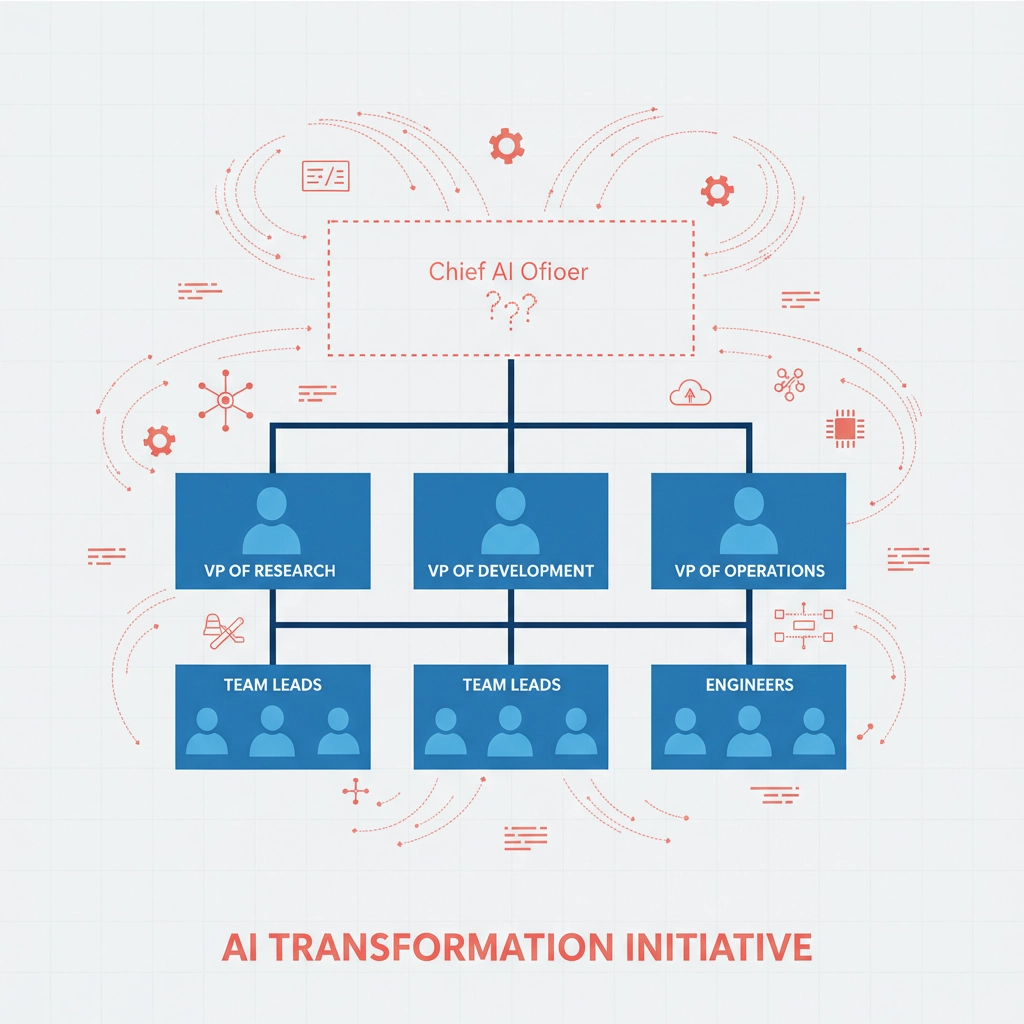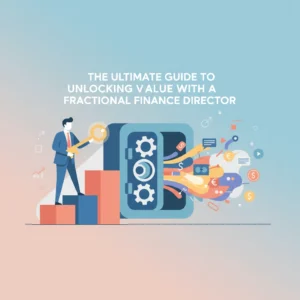The numbers don’t lie. Companies have poured between £25-30 billion into enterprise AI initiatives this year alone, yet 95% of generative AI pilots are failing to deliver any measurable financial impact. That’s not a technology problem: that’s a leadership crisis.
Whilst your competitors race ahead with AI transformations, your organisation might be stuck in the same old patterns: endless pilots that never scale, dashboards that don’t drive decisions, and meetings about meetings about AI strategy. Sound familiar?
The brutal truth? Most executives are trying to navigate 21st-century AI transformation with 20th-century leadership thinking. And it’s costing businesses millions.
Here are the seven warning signs that your business desperately needs an executive who actually gets AI: and what happens when you don’t act fast enough.
1. Your AI Investments Are Burning Money, Not Making It

You’ve spent six figures (maybe seven) on AI tools, platforms, and consultants. Your tech stack looks impressive on paper. But when the board asks for ROI figures, you’re shuffling through vague metrics about “improved efficiency” and “future potential.”
The reality check: 65% of organisations report their AI initiatives have fallen short of expectations, with the average failed digital transformation project costing £12 million. That’s not bad luck: that’s bad leadership.
Companies with proper AI leadership see 2.3 times higher adoption rates and 28% higher revenue growth. The difference isn’t the technology they’re using; it’s the executive vision guiding implementation.
If your AI spending feels like feeding coins into a slot machine, hoping for a jackpot that never comes, you need leadership that understands how to align AI strategy with actual business outcomes.
2. You’re Still Using Traditional Change Management for AI
Here’s where most businesses trip up spectacularly. You’re treating AI implementation like any other technology rollout: following the same change management playbook you used for your CRM upgrade five years ago.
78% of organisations using traditional change management approaches for AI implementation struggle with adoption beyond basic use cases. These outdated methods carry a 42% failure rate, whilst organisations with AI-focused change leadership see 3.2 times higher profit margins.

AI isn’t just another software deployment. It’s a fundamental shift in how work gets done, how decisions get made, and how value gets created. If your leadership team is approaching it like a standard IT project, you’re setting yourself up for expensive disappointment.
The executives who “get it” understand that AI transformation requires entirely different frameworks, communication strategies, and success metrics than traditional change initiatives.
3. “Leadership Alignment” Is Your Biggest Headache
When asked about the primary obstacles to AI success, if “getting leadership on the same page” keeps topping your list, that’s a massive red flag.
Organizations without unified AI leadership vision find themselves trapped in pilot purgatory: endless small experiments that never scale because there’s no coherent strategy connecting them.
The stark contrast: companies with AI-active senior leaders achieve dramatically higher success rates. When leadership actually understands AI’s potential and limitations, they can make the strategic decisions that turn pilots into profits.
If your executive team is still debating whether AI is “just a fad” or arguing about which department should own AI initiatives, you’re already behind competitors who sorted this out months ago.
4. You’re Drowning in Data But Starving for Insights
Your business generates massive amounts of data every day: sales figures, customer interactions, operational metrics, website analytics. You’ve got dashboards coming out of your ears.
But when it comes to extracting actionable intelligence from all this information? Cricket sounds.

Data sits in silos across multiple systems. Reports get generated but don’t inform strategy. Your team can tell you what happened last quarter but struggles to predict what’s coming next quarter.
This paralysis indicates the absence of AI leadership capable of implementing sophisticated machine learning processes that transform raw data into strategic intelligence. Without executives who understand how to architect data systems for AI success, you’ll remain perpetually reactive rather than predictive.
5. You Don’t Have a Chief AI Officer (Or Equivalent)
This one’s simple: organisations with Chief AI Officers see 10% greater ROI on AI spending and are 24% more likely to outperform peers on innovation.
Some companies with proper AI leadership have seen 27% productivity boosts, with pilots saving 300+ hours in just 30 days. Meanwhile, organizations report that AI-powered processes capable of handling the work of 20+ staff members remain completely untapped.
If you don’t have dedicated AI leadership at the executive level, you’re treating AI as an IT project rather than fundamental business transformation. That’s like having your facilities manager oversee your digital marketing strategy: technically possible, but probably not optimal.

The absence of this role signals that your organization hasn’t grasped AI’s strategic importance. Whilst competitors appoint AI-focused executives who can bridge the gap between technology possibilities and business reality, you’re falling further behind every quarter.
6. Cross-Functional AI Collaboration Doesn’t Exist
AI initiatives remain locked within individual departments. Marketing has their tools, sales has theirs, operations does their own thing. IT manages the infrastructure, but nobody’s connecting the dots strategically.
Organizations with cross-functional AI teams are 3.1 times more likely to report successful outcomes. Companies with dedicated “AI sandboxes” for experimentation show 67% higher innovation rates.
The lack of collaborative structures indicates leadership hasn’t created frameworks necessary for AI to permeate the organization effectively. When departments work in isolation, you get fractured implementations that deliver fractional results.
Executives who truly understand AI create environments where teams can explore and integrate AI across traditional boundaries, multiplying impact rather than duplicating effort.
7. Your Team Is Burning Out on Failed AI Promises
Employee engagement around AI initiatives is tanking. Your workforce shows resistance to new AI tools, exhaustion from previous failed implementations, or increasing turnover related to transformation efforts.
This isn’t just about change fatigue: it’s about leadership credibility.
Organizations with effective AI change leadership see 34% higher employee retention and 45% faster project completion rates. When leadership can articulate a clear vision, provide proper support, and deliver on AI promises, teams engage enthusiastically.

But when 40% of new leaders get fired, forced out, or quit within their first 18 months because they fail to deliver on transformation promises, it becomes clear that traditional leadership skills aren’t sufficient for guiding AI success.
If your best people are jumping ship because they’ve lost confidence in your AI direction, you need executives who can restore credibility through competent execution.
The Cost of Staying Put
The gap between AI leaders and laggards isn’t about technology investment: it’s about leadership approach, and this gap widens every quarter.
In 2025, 64% of executives expect significant industry transformation thanks to major AI investments. Companies successfully navigating AI transformation report 28% higher revenue growth, whilst those maintaining the status quo risk obsolescence.
The time for incremental change has passed. Organizations must embrace comprehensive AI leadership or accept the consequences of falling behind permanently.
If you’ve recognised your business in these seven signs, the solution isn’t more technology or bigger budgets. You need executives who combine deep AI understanding with practical business acumen: leaders who can bridge the gap between technological possibility and commercial reality.
Because in the AI economy, having executives who “get it” isn’t just advantageous. It’s essential for survival.
Ready to explore how fractional AI leadership could transform your business? Discover our IT leadership services and see how the right executive can turn your AI investments into measurable results.


